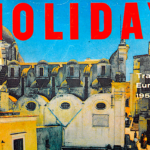At the outset of summer in 1990, a Houston gangsta rap group called the Geto Boys was poised to debut its self-titled third album under the guidance of hip-hop guru Rick Rubin. What might have been a low-profile remix release from a little-known corner of the rap universe began to make headlines when the album's distributor refused to work with the group, citing its violent and depraved lyrics. When The Geto Boys was finally released, chain stores refused to stock it, concert promoters canceled the group's performances, and veteran rock critic Robert Christgau declared the group "sick motherfuckers."
One quarter of a century later the album is considered a hardcore classic, having left an immutable influence on gangsta rap, horrorcore, and the rise of Southern hip-hop.
Charting the rise of the Geto Boys from the earliest days of Houston's rap scene, Rolf Potts documents a moment in music history when hip-hop was beginning to replace rock as the transgressive sound of American youth. In creating an album that was both sonically innovative and unprecedentedly vulgar, the Geto Boys were accomplishing something that went beyond music. To paraphrase a sentiment from Don DeLillo, this group of young men from Houston's Fifth Ward ghetto had figured out the "language of being noticed" — which is, in the end, the only language America understands.
Potts' psycho-geographical exploration of the Geto Boys' widely censored 1990 album goes beyond music criticism and wrestles with something deeper. ...As each short chapter adds another layer to the narrative, the story of Houston's pioneering gangsta rappers begins to sound like a secret history of late-twentieth-century America. —Philadelphia Inquirer
The Geto Boys is a welcome addition to the 33 1/3 canon, as it brings some much-needed diversity on several levels...Potts delivers a strong history lesson that is well-researched and gives the Geto Boys their due as hip-hop pioneers. —Houston Press
Potts doesn't come right out and say he's approaching gangsta rap as a travel writer, but his analysis [of The Geto Boys] is firmly rooted in attention to place, and the histories that inform it. ...[An] intriguing journey into an album and an area of Houston that feel relevant and essential, even though they lie well off the beaten path of American pop-culture. --Chicago Newcity
If you’re looking for a book that is not just about music but the cultural factors that surrounded an album's origins, this is the perfect choice. —HiFi Noise
Introduction
Hip-hop, particularly gangsta rap, also attracts listeners for whom the “ghetto” is a place of adventure … an imaginary alternative to suburban boredom. — Robin D.G. Kelley, “Lookin’ for the ‘Real’ Nigga” (1997)
One year after I graduated from college, having saved up some money from a landscaping job in the Pacific Northwest, I set out to explore North America by Volkswagen Vanagon for what eventually became eight months. At that point in my life I’d traveled so little that most every place on my itinerary felt laced with novelty and excitement. Over the course of that year I would survive the devastation of southern California’s Northridge earthquake, subject myself to the drunken scrum of a New Orleans Mardi Gras, and set foot in New York City for the very first time. I would hike to the bottom of the Grand Canyon, raft North Carolina whitewater, camp in the mountains of Vermont, and backpack through fire-scarred Yellowstone backcountry.
Of all the places I was about to experience that year, however, no metropolis or national park topped the sense of anticipation — and foreboding — I felt whenever I considered my plans to visit Fifth Ward, Texas.
Known locally as the “Bloody Nickel,” Houston’s notoriously violent Fifth Ward was anything but a tourist destination. It was, as the Texas Monthly put it, “Texas’ toughest, proudest, baddest ghetto.”[i] My fascination for this place was connected to its real-life reputation for danger, but its allure went beyond its day-to-day reality as a gritty, sprawling slum on the northeast edge of downtown Houston. In my imagination, the Fifth Ward was a mythic territory on a par with Mordor or Tombstone, a place where deranged killers wielded chainsaws, drug-trade gun battles wiped out gang bangers by the dozens, women rewarded brawn and cruelty with sex, and all signs of weakness were punished with beat-downs. This violent, fantastical vision of the city — a vision so arresting and so unsettling that I wound up setting out to see Fifth Ward for myself — was the result of my brief obsession with a 1990 gangsta rap album entitled The Geto Boys.
I’d first become aware of The Geto Boys a few years earlier, in July of 1991, when two Kansas teenagers claimed that listening to the album had inspired them to murder a 26-year-old man in Dodge City. I was living in my hometown of Wichita that summer, working as a news intern at the local ABC affiliate. Each morning, as I edited video and rehashed AP wire reports for the Good Morning Kansas show, I kept track of developments in the Dodge City case. According to defense lawyers, the song “Mind of a Lunatic” had driven 16-year-olds Christopher Martinez and Vincent Perez into a state of temporary insanity, leading them to shoot a stranger named Bruce Romans in the head as he walked across a bridge at the edge of town. “It was partly liquor, partly marijuana, and — probably most of all — it was a rap tape of the Geto Boys,” Martinez’s attorney had told the court while outlining the teens’ motivation for the shooting. “There is an imminent danger to young people getting hold of this thing,” Perez’s lawyer added, brandishing a cassette of The Geto Boys. “It can literally mesmerize you from the repeated bass sounds. The words are horrible — it’s about raping and killing.”[ii] Both lawyers argued that the lyrics to “Mind of a Lunatic” read like an incantational prescription for murder.
That August, when I returned to the college I’d been attending in Oregon, I discovered that one of my dormitory roommates had just bought a CD copy of The Geto Boys. Its black-and-white cover art displayed realistic-looking mugshots of four tough-looking black men; its track listing featured songs like “Fuck ’Em,” “Let a Ho Be a Ho,” and “Trigga Happy Nigga.” The lyrics — angry, graphic celebrations of violence and depravity — were unimaginably offensive. Within a week, my roommates and I were blasting the album on a nightly basis.
It is difficult, when you're a middle-class white guy, to describe the experience of listening to hardcore gangsta rap without making yourself sound a bit ridiculous. For all of the high-stakes scenarios that underpinned the Geto Boys’ tracks — drug deals, beat-downs, murder — I rocked those songs in the low-stakes environs of my dormitory suite. While in real life the Geto Boys presumably worried about drive-by shootings and police brutality, my world revolved around homework and track practice, tentative female flirtations, and dipshit male rivalries. In a certain sense, I cranked the tracks on The Geto Boys not to reflect on their meaning, but because (as was the case with songs by Pantera and Ministry) they made me feel faintly off-kilter, amped-up, larger than the moment I was living in. Unlike those metal and industrial bands, the Geto Boys’ unabashed raunch and brutality also pushed me into uncomfortable emotional directions. The more offensive the song was, the more I responded to it; I felt hilarity and shame when I listened to “Gangster of Love,” thrill and horror when I cued up “Mind of a Lunatic.” And, fantastical as the Geto Boys’ lyrical narratives sounded, the fact that they were pegged to a real place — Fifth Ward — made their angry rejection of social rectitude feel more real somehow.
I’m not sure when I first got the idea to travel to inner-city Houston in person. It probably started out as an off-hand joke with my roommates, since the Geto Boys’ vision of Fifth Ward had grown into a metaphor of sorts to us — an action-packed inversion of the life we led on our safe, sleepy, exurban Oregon campus. Moreover, given the insipid pop-culture atmosphere of the time, when corporate record labels were still pushing lame rock and rap acts like Warrant and Vanilla Ice (Nirvana’s game-changing Nevermind wouldn’t drop for another month), I thrilled at the Geto Boys’ profane, provincial, neighborhood-specific urban hauteur. Their Fifth Ward gangsta pose was, in many ways, an echo of N.W.A’s mythified Compton, but by late 1991 (after John Singleton’s Boyz n the Hood had been a huge box-office success) inner-city Los Angeles felt like a known entity, a place of palm trees, barbecues, and tricked-out low-riders. By contrast, Fifth Ward felt raw, gritty, devoid of glamour. A few years later, as I planned out my multi-month journey around North America, the fascination for Fifth Ward remained. My itinerary for Texas included a number of iconic travel attractions (including Amarillo’s Cadillac Ranch and Austin’s Sixth Street indie-rock clubs), but no destination held the same appeal for me as did the run-down urban area northeast of downtown Houston.
Hip-hop scholar Tricia Rose has described white consumption of commercial hip-hop as “ghetto tourism,”[iii] and my desire to visit the Fifth Ward might be seen as a literal manifestation of that complicated notion, no doubt intertwined with a degree of cross-cultural voyeurism and “exoticism” (i.e. the desire for a brief experience that “posits the lure of difference while protecting its practitioners from close involvement”).[iv] But my motivation was just as much tied to frustration with the prescribed rituals of tourism, which invariably steer visitors to comfortable, class-appropriate attractions that underscore America’s idealized vision of itself. Though I might not have articulated it quite this way at the time, the parts of Houston that had benefited from Cold War-era investment (like the tourist-friendly Lyndon B. Johnson Space Center) felt far less worthy of my attention than parts of the city that had suffered from Cold War-era neglect. As a middle-class urban consumer, I’d been urged to ignore places like the Fifth Ward; as a fan of The Geto Boys, I felt compelled to see it for myself.
On a practical level, wandering uninvited into the most dangerous neighborhood in Texas posed a problem. I spent the weeks leading up to my visit stewing over this challenge before a late-night viewing of Cops gave me an epiphany. The following morning I dialed directory assistance, tracked down the northeast substation of the Houston Police Department, and reserved myself a citizen ride-along.
Like any travel experience, Houston proved surprising in ways that simultaneously confirmed and refuted my Geto Boys-tinged expectations of the place. Moreover, despite the fact that my career as a writer would take me around the globe many times over the next two decades, I’ll confess that I’ve never quite had a travel experience like the one I had in Houston, in part because no other album has disturbed and enthralled me quite like The Geto Boys. And, despite the fact that Nirvana’s Nevermind is the album most strongly associated with the early 1990s, I’d argue that the Geto Boys achieved something far more emblematic. By the end of the decade, grunge had long since burned itself out, while hip-hop had burst free of its East Coast–West Coast polarity to become the most popular style of music in America.
One could argue, with good reason, that any of a dozen hip-hop albums from the early 1990s (including the Geto Boys’ 1991 We Can’t Be Stopped) might be considered more influential than The Geto Boys. But, in creating an album that was both sonically innovative and unprecedentedly vulgar, the Geto Boys had accomplished something that went beyond music. To paraphrase a sentiment from Don DeLillo’s Mao II, this group of young men from Fifth Ward, Texas had figured out the “language of being noticed” — which is, in the end, the only language America understands.
This book explores how that happened.
[i] Richard West, “Only the Strong Survive,” Texas Monthly, February 1979.
[ii] R.A. Dyer and Rick Mitchell, “Geto Boys’ Music Blamed in a Slaying in Dodge City,” Houston Chronicle, July 23, 1991.
[iii] Tricia Rose, The Hip Hop Wars (Basic Civitas Books, 2008).
[iv] Graham Huggan, The Postcolonial Exotic: Marketing the Margins (Routledge, 2001).





